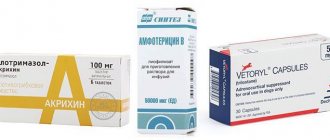Insect bites cause an allergic reaction in animals . They provoke flea dermatitis in cats with saliva, which, according to scientists, contains about 15 allergens. The disease is not dangerous for humans, but pets suffer from itching and inflammation of the skin.
The peak of the disease occurs in the warm season. Kittens rarely become infected with dermatitis . Most often, cats suffer from it when they reach 1-2 years of age. One flea bite can trigger the disease.
The first signs of allergies
The reaction to flea bites in cats manifests itself in different ways, which depends on the characteristics of the animal’s body. In some individuals, the allergy manifests itself immediately and acutely, while in others it occurs with virtually no symptoms.
Signs of allergies are as follows:
- Itching and scratches from claws. The animal often itches and injures itself.
- Inflammation . Redness appears in some areas.
- Papules. At the sites of insect bites, small growths appear with suppuration in the center.
- Dark spots. One of the reactions to an allergen is a change in skin color.
- Swelling. May appear on the eyes, ears and mucous membrane of the larynx.
Allergy
Important! In advanced cases, the pet exhibits more obvious symptoms: sneezing, coughing and light discharge from the eyes.
Treatment must be carried out immediately, otherwise anaphylactic shock may occur.
Preventive actions
Knowing that your pet is prone to allergies to insect bites, you should take a number of preventive measures in advance to prevent the development of dermatitis.
Recommendations from professionals
The following activities help:
- Periodic use of antiparasitic drugs, regardless of the presence of fleas on the pet.
- Processing animal care items, rugs, resting areas.
- Careful and regular examination of the dog.
- Protecting your pet from contact with stray animals.
- Choosing places to walk that provide less risk of parasites.
- Strengthening the immune system with a balanced diet and vitamin and mineral complexes for the dog.
Careful animal care includes hygiene procedures.
The dog is bathed regularly, not forgetting to wash the anus, and comb the hair. Parasites will appear in dirty, caked tangles faster than on clean, silky wool.
Change in animal behavior
Flea allergies affect not only the pet’s skin, but also its psycho-emotional state. As a result of stress, an animal may fall into apathy: lose interest in what is happening around it, spending a significant part of its time lying down. The cat's appetite also decreases.
In rare cases, a reverse reaction is observed. The pet becomes aggressive and does not allow itself to be touched. When stroking the fur, the animal begins to meow pitifully, moving away from the hands.
Treatment of children
Do not use drugs for children that are prescribed for adult patients. This is due to the concentration, dosage, and active ingredients found in the medications. Drugs are prescribed only taking into account the patient’s age, weight, and health status.
In this case, the affected areas are treated with hydrogen peroxide or Chlorhexidine. Alcohol solutions are also used for processing. Antihistamines may be prescribed; they are sold from pharmacies only with a prescription. To relieve pain and get rid of itching, the child is prescribed ointments for external use.
Folk remedies can also be used, but only after consultation with the attending physician. For example, you can use a mixture of lemon juice and honey, from which compresses are made. Decoctions of calendula, plantain, mint, and bird cherry are also used. A fairly effective method is a mixture of soda and ammonia.
Diagnosis of flea dermatitis
The presence of an allergic reaction can be determined both by the pet’s behavior and by examining its sores. But without laboratory tests, all these are only indirect signs. An accurate diagnosis can only be made by a specialist – a veterinarian.
In a clinical setting, swabs and blood are taken from the animal. In some cases, the doctor performs an allergen test. The fact is that in cats, flea allergy has similar symptoms to other diseases: pediculosis, pemphigus foliaceus, sarcoptic mange, etc. Therefore, you cannot limit yourself to just a visual inspection and routine tests.
Symptoms of allergic dermatitis
Itching, scratching,
baldness
Cough, sneezing
Drooling, vomiting, diarrhea
Seizures, loss of coordination
Lethargy, depression, loss of consciousness
All these symptoms can occur both in case of allergies and in case of poisoning with the active substance of the collar. Naturally, the most dangerous symptoms are more characteristic of poisoning, while allergies are most often characterized by itching and scratching around and under the collar.
If you do buy a collar and put it on your cat, then carefully monitor the animal during the first day of wearing it. At the first signs of allergy or poisoning, immediately remove the collar and write down its active ingredient so that you never buy or use products with it again. If symptoms appear within an hour after using the collar, we have an allergy; within 5-6 hours, we have poisoning.
Do not forget that in any situation, including in this case, you need to consult with an experienced veterinarian, since no articles allow you to make a diagnosis in absentia and prescribe the correct treatment at home for allergies in dogs and puppies to various allergens .
If redness is noticed in the dog's ears or the dog constantly scratches the ear and shakes its head, these are signs of an allergy. There may be a persistent brown discharge from your dog's ears. It is imperative to treat such an allergy, otherwise it can develop into otitis media.
A competent specialist will recommend changing the food, as this is a possible food allergy. It is advisable to buy dietary food. To cure allergies you will need suprastin or diazolin, the dosage depends on the weight of the dog. At this time, it is useful to include vitamins, fish oil and fresh vegetables in your dog's diet.
Allergies manifest themselves in dogs in different ways. This may include itchy skin, vomiting, intestinal upset, bald areas, red eyes. To identify and promptly treat allergies in your pet, you should change food. It is important to exclude beef, pork, chicken, and turkey from your dog’s diet.
Perhaps the allergic reaction is caused by the presence of fleas on the animal's body. You need to carefully monitor your pet's behavior to determine at what point its behavior changes. You need to bathe your dog more often, ventilate the room, and switch to low-protein diet food.
To combat allergies from insects, the animal should be treated with an ointment based on calendula and arnica. And the dog should be given suprastin.
If allergies occur in small breed dogs, you should use 2-3 generations of products or
Gas - a rubber collar releases the active substance gradually, poisoning insects. Fleas concentrate in the tail area, become lethargic and die. It lasts 4-6 weeks, after which the collar needs to be replaced.
Ultrasonic – rarely used due to its high cost. They emit a spectrum of ultrasonic waves that are safe for cats and repel insects in
Today, a large number of people suffer from various types of allergic reactions. Unfortunately, recently there have been more and more cases of allergies in dogs. A significant number of veterinarians even believe that we are currently experiencing an “allergy epidemic.” No one can name the exact reasons for such an epidemic, but it is assumed that they may include excessive vaccination of dogs, the results of poor breeding, as well as substances used in dog food.
Absolutely all dog breeds can be prone to allergies. Allergic reactions usually occur in dogs over 2 years of age, although cases of allergies have also been reported in young puppies. This means that dogs who suffer from allergies often have to endure them their entire lives, with symptoms only getting worse as they age.
Dogs tend to have more severe allergic symptoms than humans. While plant pollen can cause sneezing and watery eyes in humans, it can cause itchy paws in dogs, causing them to constantly lick and bite. The most common allergy problem in dogs is scratching.
If you notice any of the symptoms described above, your best option is to contact your veterinarian, who will prescribe the appropriate treatment. In most cases, allergy treatment involves finding and eliminating the allergen.
We suggest you read: How long do fleas live without an animal in an apartment and where do they live?
An allergic reaction to fleas (see photo below) is very common in dogs. In fact, this is a reaction to a flea infestation
The special structure of the mouthparts in the shape of a needle helps the insect pierce the skin. After which the pest sucks blood from nearby capillaries.
The last point is worth talking about in more detail.
To determine whether a cat has fleas or other parasites, know the following:
- The animal incessantly itches with its hind legs and bites itself in those places where the parasite bothers.
- A restless cat, he often does not lie in one place and even jumps up when he sleeps. A large number of parasites leads to a decrease in the pet’s appetite.
- If you part the fur, you will find insects, excrement in the form of blackheads and nits (eggs that are laid in the fur).
- In cats, bloodsucker bites cause an allergic reaction, which is why scratching and blood scabs are observed on the skin under the fur. In a family with children, a child may also develop a flea allergy.
Fleas in cats have distinctive features from other parasites:
- Jumping (while bathing or brushing);
- They bite in different places (ticks and bedbugs prefer softer and more tender places);
- Causes allergic dermatitis.
What do cat parasites look like? Insects that predominate exclusively on cats differ in appearance from their canine, rat, and rabbit relatives. Knowing what a representative of cat parasites looks like is necessary to protect yourself and your pet from the diseases they carry.
Cat fleas and cat lice are different types of parasites. Destruction of lice is much easier from the body. This is explained by the fact that bloodsuckers exist without a host. If there are lice on a pet, then the fleas drive them out when they move in. They settle on small animals, rats, and the cat is not the main owner. These are small dark insects that have different sizes depending on age - from 1 mm to 4 mm. The whole body shines.
The insect perfectly jumps up to 30 cm in height at such a speed that human vision is not able to follow the movement of the parasite in flight. The flattened body on the sides and elongated hind legs contribute to fast jumps and less air resistance.
The parasite has a strong chitinous frame, so it will not be possible to crush it with your fingertips.
The parasite lives in secluded corners: grass, garbage, under stones, and in an apartment under baseboards, under the carpet and even in human clothes. The animal is food and means of transportation for the bloodsucker. The animal's blood serves as a stimulant for egg laying. If the female is hungry, then she will not carry out her reproductive function.
Bites are noted separately. Unlike other parasites, it does not contain painkillers in its saliva, so when it digs into the skin, the pet experiences severe pain. With saliva it carries various infectious agents that pose a danger to humans:
- Brucellosis;
- Encephalitis;
- Salmonellosis;
- Plague;
- Hepatitis;
- Typhoid fever.
flea cat
Therefore, they get rid of annoying insects both from the pet’s body and drive them out of the apartment or house.
The presence of ectoparasites is determined by examining the cat, during which fleas themselves or their remains are found on the fur and skin. If it was not possible to visually detect parasites, you can conduct an experiment.
Treatment regimens for cat allergies
To treat allergies, killing fleas alone is not enough. In many felines, the residual reaction can last up to 45 days. Drug therapy is selected taking into account the animal’s condition and existing symptoms.
Symptomatic therapy
In this case, allergies to flea bites in cats can be treated with hormonal medications. In a good half of cases, veterinarians prescribe Prednisolone and Dexafort to the animal. The latter also stops excessive aggression.
Antihistamine solutions, such as Suprastin or Tavegil, are most often used as auxiliary agents.
Suprastin
If your pet is often outside, the risk of re-infestation increases significantly. In such cases, specialists carry out immunotherapy, which is similar in principle to conventional vaccination. A small dose of the allergen is injected into the animal's body. The immune system begins to produce antibodies to it, the number of which increases over time. Upon subsequent contact, the body will not react so sharply to the familiar allergen. But before treating your pet with immunotherapy, you will need to undergo a series of tests.
Antibiotics for severe cases
If the wounds become infected and inflammatory processes begin, then hormonal agents alone cannot be used. For an acute allergic reaction and subsequent complications, the veterinarian will prescribe antibiotics.
For reference! As a rule, broad-spectrum drugs are used. The course of treatment lasts approximately two weeks. The duration of use depends on the body's response to the antibiotic.
Cat skin restoration
The consequences of allergies are reflected primarily on the pet’s skin and fur. The hairline loses its former shine, and in advanced cases it even falls out. For recovery, special preparations rich in vitamins, minerals and fatty acids are required, for example, Nordic Omega-3 or Medizinal Dorsch Lebertran L.
Veterinarians also recommend switching your pet to dry food with a therapeutic effect: Derma ProPlan Plus, Royal Canin Skin, etc. Such food contains all the elements necessary for the rehabilitation of hair.
In difficult cases, drops for hair are additionally prescribed: Dermoscent Essential 6 or Allerderm.
Treatment at home
Treatment at home includes taking medications and following a special diet.
Medicines for helminths
The drug is selected depending on the type of disease:
- Scabies from flea bites is treated with special drops and sprays. Anti-flea shampoos are used during bathing. Then a flea collar is put on the animal.
- Itching caused by fungal infections is eliminated with drugs from the griseofulvin group. The antifungal agent is applied externally. You can also get vaccinated.
- To get rid of ticks, acaricidal substances are used in the form of drops, sprays and shampoos. Drops against ear mites are instilled into the ears.
- To eliminate allergic reactions, it is necessary to remove the allergen from the diet and care products. For further treatment, antihistamines are used.
- Deworming medications help get rid of worms. During the examination, the doctor identifies what type of worms have affected the intestines and prescribes appropriate treatment.
- Dermatosis, otitis media and other infectious diseases are treated with antibiotics and anti-inflammatory drugs. To strengthen the immune system, the animal is prescribed vitamins A and B and immunostimulating drugs.
- Allergic dermatitis and ear scabies are treated with Stronghold. This drug is released in the form of drops that are applied to the animal’s neck. It also helps with flea bites.
Getting rid of fleas in the house
To prevent re-infestation, the entire house should be treated for parasites. Fleas can jump from a pet to interior items, and then return to the host again. Particular attention should be paid to upholstered furniture, carpets and other fleecy coverings where the insect can hide.
Raptor
It is also necessary to treat all places where there are cracks: baseboards, decorative panels, radiators, etc. Flea insecticides can be purchased at any hardware or pet store. It is better to focus on proven solutions: Get, Kombat, Raptor, Tetrix, etc.
Possible consequences of allergies
When the parasite bites, it secretes saliva, which contains allergens. The pet begins to actively itch and bite the skin with its teeth. As a result, the epidermis becomes covered with wounds, which increase with each subsequent comb. Thus, a prolonged flea allergy in cats provokes infection with various infections that penetrate through the wounds.
For reference! Any infection aggravates the course of the allergic reaction. As a result, additional foci of inflammation are formed: pus accumulates, and the animal experiences severe pain, scratching itself even more actively.
Allergies undermine the pet’s immune system: the intensity of the body’s fight against viruses decreases or disappears altogether. In this case, the general condition of the animal noticeably worsens: there is lethargy, lack of appetite and indifference to everything that is happening around.
Prevention of itching: does it exist at all, and what can be done?
Itching is caused by various factors, so following a number of prevention rules will help protect your cat from scratching:
- Poison worms in a timely manner. This will also help protect children who constantly play with animals. You should not give your cat raw foods: fish, meat.
- After each walk, inspect the animal for abrasions. Treat detected wounds with iodine or other disinfectants.
- To avoid infection with parasites, the cat should not be allowed to come into contact with other animals.
- Disinfect the cat litter box regularly.
- The transition to a new food should be carried out gradually.
- Do not punish your cat for minor offenses: this will prevent stress.
Prevention of feline dermatitis
It is much easier to prevent a disease than to treat it. There is no 100% protection against fleas or allergies, but you can reduce the likelihood of your pet becoming infested. First of all, you need to follow a number of simple rules:
- The most effective measure is to keep the animal off the street.
- Limit your pet's contact with other animals.
- Wash your cat at least 2 times a year using flea and worm shampoo.
- Buy a special collar against blood-sucking parasites.
- Carry out regular cleaning of the house.
Treatment of dermatosis with folk remedies
Flea infestation threatens the death of cats , especially young ones, since not all medications are suitable for kittens.
In this case, use wormwood oil. It has an unpleasant odor that repels fleas and does not harm the general condition of the animal.
Garlic and brewer's yeast have a pungent odor . A mixture of these ingredients is used to treat carpets or animal bedding. Apply for 30 minutes, then remove with a vacuum cleaner.
A solution of turpentine and water is used to treat the animal and the floors in the house . To prepare the product, mix a bucket of warm water with 50 ml of turpentine.
Folk remedies do not cure a cat of fleas 100% . You will still have to use the services of a veterinarian to prescribe medication.











